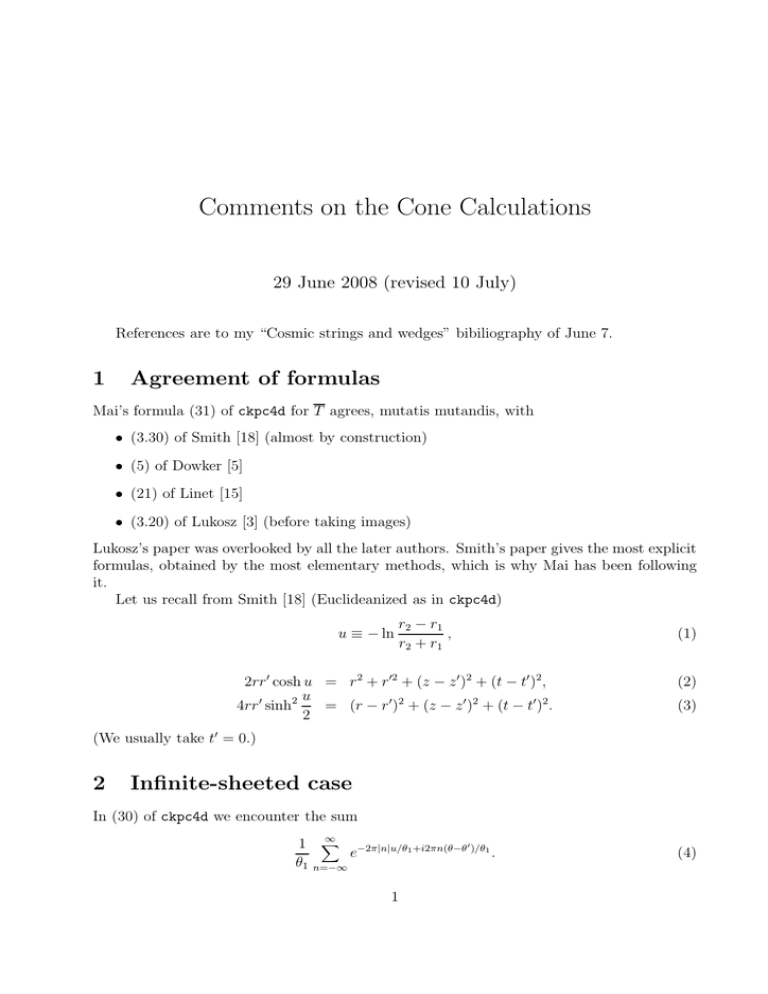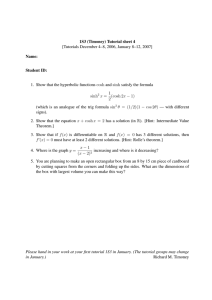Comments on the Cone Calculations 1 Agreement of formulas
advertisement

Comments on the Cone Calculations 29 June 2008 (revised 10 July) References are to my “Cosmic strings and wedges” bibiliography of June 7. 1 Agreement of formulas Mai’s formula (31) of ckpc4d for T agrees, mutatis mutandis, with • (3.30) of Smith [18] (almost by construction) • (5) of Dowker [5] • (21) of Linet [15] • (3.20) of Lukosz [3] (before taking images) Lukosz’s paper was overlooked by all the later authors. Smith’s paper gives the most explicit formulas, obtained by the most elementary methods, which is why Mai has been following it. Let us recall from Smith [18] (Euclideanized as in ckpc4d) u ≡ − ln r2 − r1 , r2 + r1 2rr ′ cosh u = r 2 + r ′2 + (z − z ′ )2 + (t − t′ )2 , u = (r − r ′ )2 + (z − z ′ )2 + (t − t′ )2 . 4rr ′ sinh2 2 (1) (2) (3) (We usually take t′ = 0.) 2 Infinite-sheeted case In (30) of ckpc4d we encounter the sum ∞ 1 X ′ e−2π|n|u/θ1 +i2πn(θ−θ )/θ1 . θ1 n=−∞ 1 (4) In the limit θ1 → ∞ it becomes the integral 1 u 1 Z∞ ′ dy e−|y|u+iy(θ−θ ) = . 2π −∞ π u2 + (θ − θ′ )2 (5) Thus T for the infinite-sheeted Sommerfeld–Dowker manifold is T (t, r, θ, z, r ′ , θ′ , z ′ ) = − u 1 . 2 sinh u u + (θ − θ′ )2 2π 2 rr ′ (6) This agrees, mutatis mutandis, with (7) of Dowker [5]. 3 Lower-dimensional case According to (2.5) Guimarães–Linet [21] (or (11) of Linet [15]) the Euclidean Green function (− 21 T ) in dimension n is obtained from the massive Euclidean Green function in dimension n − 1 by a Fourier [cosine] transform with respect to the mass. Therefore, the lowerdimensional case can be obtained from the higher one by an inverse transform; and if m = 0, the Fourier factor becomes trivial. Thus T (t, r, θ, r ′θ′ ) = 2 Z 0 ∞ T (t, r, θ, z, r ′ , θ′ , 0) dz. (7) From (2) with z ′ = 0 and t′ = 0, 2rr ′ sinh u du = 2z dz, (8) and z = 0 corresponds to u = u0 , defined in (2.16) of Smith [18] and by Mai in tft3d by cosh u0 = r 2 + r ′2 + t2 . 2rr ′ (9) Therefore, from (31) of ckpc4d, ′ ′ Z ∞ 1 πθ1 Z T (t, r, θ, r θ ) = 2rr = − ′ u0 du − r 2 − r ′2 − t2 du q . 2rr ′(cosh u − cosh u0 ) T (t, r, θ, z, r ′ , θ′ , 0) sinh u √ ∞ u0 sinh( 2πu ) θ1 ) cosh( 2πu ) − cos 2π(θ−θ θ1 θ1 ′ 2rr ′ cosh u (10) This is the same as (17) of tft3d after the sum there is evaluated as it was in ckpc4d. In any dimension, T can be constructed either 1. as a Poisson kernel for a homogeneous PDE in t > 0 with nonhomogeneous data at t = 0, by an eigenfunction expansion in the (r, θ, z, . . .) variables; or 2. as a Green function for a nonhomogeneous PDE in −∞ < t < ∞, by Fourier analysis in (θ, z, . . . , t). 2 My document ehk, following [8] and [6], shows how both formulas follow from a full harmonic analysis (of the nonhomogeneous problem) in all the variables. Mai has worked on both dimensions (total of 3 and total of 4) by both methods, but concentrated on the two approaches that matched Smith’s work, namely, method 1 (ckpc) in dimension 4 and method 2 (tft) in dimension 3. 4 Lower-dimensional infinite-sheeted case Combining the considerations of the two previous sections, we get for the Sommerfeld– Dowker manifold of total dimension 3 the result u du 1 Z∞ q T (t, r, θ, r θ ) = − 2 . 2 ′ 2 π u0 u + (θ − θ ) 2rr ′ (cosh u − cosh u0 ) ′ ′ (11) Note that in the 3D formulas u is simply a variable of integration, but in the 4D formulas it is defined in terms of the coordinates by (1) or (2). 3







